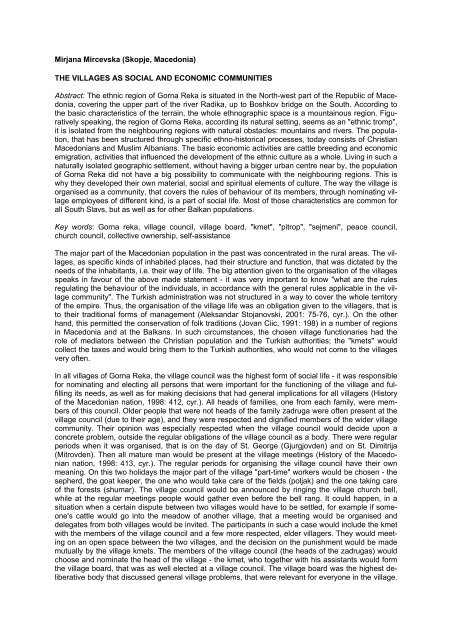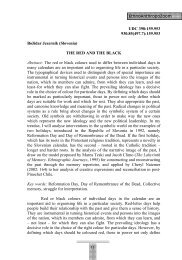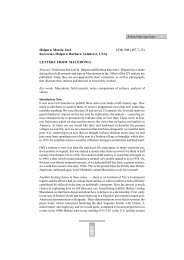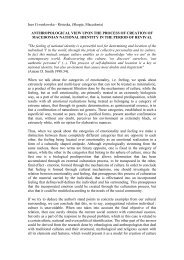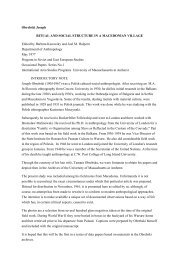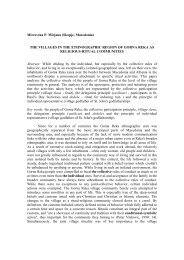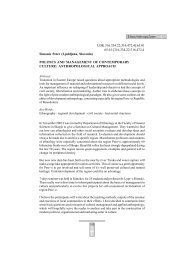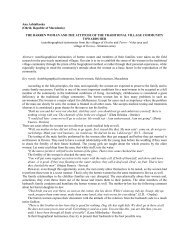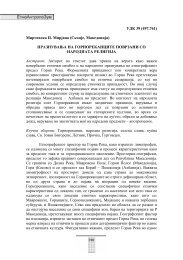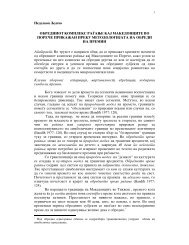The Villages As Social And Economic Communities
The Villages As Social And Economic Communities
The Villages As Social And Economic Communities
Create successful ePaper yourself
Turn your PDF publications into a flip-book with our unique Google optimized e-Paper software.
Mirjana Mircevska (Skopje, Macedonia)<br />
THE VILLAGES AS SOCIAL AND ECONOMIC COMMUNITIES<br />
Abstract: <strong>The</strong> ethnic region of Gorna Reka is situated in the North-west part of the Republic of Macedonia,<br />
covering the upper part of the river Radika, up to Boshkov bridge on the South. According to<br />
the basic characteristics of the terrain, the whole ethnographic space is a mountainous region. Figuratively<br />
speaking, the region of Gorna Reka, according its natural setting, seems as an "ethnic tromp",<br />
it is isolated from the neighbouring regions with natural obstacles: mountains and rivers. <strong>The</strong> population,<br />
that has been structured through specific ethno-historical processes, today consists of Christian<br />
Macedonians and Muslim Albanians. <strong>The</strong> basic economic activities are cattle breeding and economic<br />
emigration, activities that influenced the development of the ethnic culture as a whole. Living in such a<br />
naturally isolated geographic settlement, without having a bigger urban centre near by, the population<br />
of Gorna Reka did not have a big possibility to communicate with the neighbouring regions. This is<br />
why they developed their own material, social and spiritual elements of culture. <strong>The</strong> way the village is<br />
organised as a community, that covers the rules of behaviour of its members, through nominating village<br />
employees of different kind, is a part of social life. Most of those characteristics are common for<br />
all South Slavs, but as well as for other Balkan populations.<br />
Key words: Gorna reka, village council, village board, "kmet", "pitrop", "sejmeni", peace council,<br />
church council, collective ownership, self-assistance<br />
<strong>The</strong> major part of the Macedonian population in the past was concentrated in the rural areas. <strong>The</strong> villages,<br />
as specific kinds of inhabited places, had their structure and function, that was dictated by the<br />
needs of the inhabitants, i.e. their way of life. <strong>The</strong> big attention given to the organisation of the villages<br />
speaks in favour of the above made statement - it was very important to know "what are the rules<br />
regulating the behaviour of the individuals, in accordance with the general rules applicable in the village<br />
community". <strong>The</strong> Turkish administration was not structured in a way to cover the whole territory<br />
of the empire. Thus, the organisation of the village life was an obligation given to the villagers, that is<br />
to their traditional forms of management (Aleksandar Stojanovski, 2001: 75-76, cyr.). On the other<br />
hand, this permitted the conservation of folk traditions (Jovan Ciic, 1991: 198) in a number of regions<br />
in Macedonia and at the Balkans. In such circumstances, the chosen village functionaries had the<br />
role of mediators between the Christian population and the Turkish authorities; the "kmets" would<br />
collect the taxes and would bring them to the Turkish authorities, who would not come to the villages<br />
very often.<br />
In all villages of Gorna Reka, the village council was the highest form of social life - it was responsible<br />
for nominating and electing all persons that were important for the functioning of the village and fulfilling<br />
its needs, as well as for making decisions that had general implications for all villagers (History<br />
of the Macedonian nation, 1998: 412, cyr.). All heads of families, one from each family, were members<br />
of this council. Older people that were not heads of the family zadruga were often present at the<br />
village council (due to their age), and they were respected and dignified members of the wider village<br />
community. <strong>The</strong>ir opinion was especially respected when the village council would decide upon a<br />
concrete problem, outside the regular obligations of the village council as a body. <strong>The</strong>re were regular<br />
periods when it was organised, that is on the day of St. George (Gjurgjovden) and on St. Dimitrija<br />
(Mitrovden). <strong>The</strong>n all mature man would be present at the village meetings (History of the Macedonian<br />
nation, 1998: 413, cyr.). <strong>The</strong> regular periods for organising the village council have their own<br />
meaning. On this two holidays the major part of the village "part-time" workers would be chosen - the<br />
sepherd, the goat keeper, the one who would take care of the fields (poljak) and the one taking care<br />
of the forests (shumar). <strong>The</strong> village council would be announced by ringing the village church bell,<br />
while at the regular meetings people would gather even before the bell rang. It could happen, in a<br />
situation when a certain dispute between two villages would have to be settled, for example if someone's<br />
cattle would go into the meadow of another village, that a meeting would be organised and<br />
delegates from both villages would be invited. <strong>The</strong> participants in such a case would include the kmet<br />
with the members of the village council and a few more respected, elder villagers. <strong>The</strong>y would meeting<br />
on an open space between the two villages, and the decision on the punishment would be made<br />
mutually by the village kmets. <strong>The</strong> members of the village council (the heads of the zadrugas) would<br />
choose and nominate the head of the village - the kmet, who together with his assistants would form<br />
the village board, that was as well elected at a village council. <strong>The</strong> village board was the highest deliberative<br />
body that discussed general village problems, that were relevant for everyone in the village.
<strong>As</strong> it was more or less the case with all South-Slav people, as well as with the Macedonians, the<br />
kmets were respected people that managed the village community, taking care of it. Each village<br />
elected its own head that was a part of the village population. <strong>The</strong> head of the village or the head of<br />
the family had to be a respected person, primarily in the frames of his own family community. Since<br />
the head of the families in Gorna Reka was always the oldest member who was still able to work, the<br />
kmet would be elected from this group of people. It could happened that the head of the village would<br />
not be a head of a family zadruga, or that he would transfer the management of the family to his eldest<br />
son or that he could even split the zadruga so that he could work only for the benefit of his covillagers<br />
and the village as a community. <strong>The</strong> authority of the kmet in this region was extremely important<br />
due to the historical circumstances in which people would live, as well as due to the continuos<br />
fight that had to be fought with the gangs that would enter, burn and rob the Gorna Reka villages. <strong>The</strong><br />
verbal communication that these people had with the Turkish (Albanian) authorities ("agas" and<br />
"begs") was extremely important. Often it was them to save the villages and the villagers from being<br />
murdered, kidnaped, especially when it came to the children for whom the kidnapers would ask ransom<br />
1 , returning of stolen cattle etc. <strong>The</strong>se were the focal obligations of the head of the village. <strong>The</strong><br />
role of a mediator between the villagers and the authorities was very important, since such kind of<br />
problems happened all the time. <strong>The</strong> population was attacked on daily basis, the villages were<br />
robbed, thus the power and the authority that the kmet of Gorna Reka should have with the Turkish<br />
authorities had to be really big. Life of people would depend upon his authority and ability. <strong>The</strong> kmet<br />
would negotiate with the robbers' gangs, that is, their leaders: Ljoke and Osman were great robbers in<br />
this areas remember them. <strong>The</strong>y knew that Tanash has money so the gang would come and rob him.<br />
Ljoke and Osman would come to us since my old man was the kmet" 2 . Through the history of Gorna<br />
Reka in the period of the Turkish empire there were kmets that played a big role in the whole region<br />
of Gorna Reka. Such was the case of the "kmet Rade from the family of Bibaj, who was a kmet of all<br />
16 villages" 3 . How important was the kmet could be seen from the information that speaks about a<br />
case that happened in the village of Vrbjani (Gorna Reka) when the whole village has changed its religion<br />
and folk costume. Since all villagers have changed their religion, that is have turned into Muslims,<br />
and not just one part of the population, as ordered by the kmet Rade Bibaj (a few members from<br />
each family), then "the kmet punished them, neither Dolna Reka nor Gorna Reka to exist. <strong>The</strong>y<br />
should not wear our costume, but to wear another one. An us here, orthodox and Muslims, Macedonians<br />
and Albanians, we are speaking one language, and we are wearing one costume". 4 This information<br />
proofs the already established method of Islamization of this village institution, as well as its<br />
survival among this population. <strong>The</strong> head of the village had other obligations. Among other things he<br />
decided, in accordance with the members of the village council, when should the cattle be taken to<br />
the fields, which part of the mountain will be used in the following year for cattle feeding, to whom it<br />
would be allowed to "buy" a village mountain for cattle feeding, where from could one cut trees for the<br />
winter and other needs of the villages, in one word he would "take care of the order in the village".<br />
<strong>The</strong> number of live stock that a villager could have "for free" to feed the stock on the village mountain<br />
would be strictly limited to 40 sheep or less sheep but more other types of cattle (cows and horses),<br />
however the number of the live stock should not exceed 40. Those households that had bigger herds<br />
of sheep and other cattle had to "buy" the mountain. 5 In that sense the villagers had to pay a certain<br />
1 1 <strong>The</strong> most famous robber in the region of Gorna Reka who would not only robb but also kidnaped children<br />
and then asked for ransom frmo their parents, was a person called Sabrija from Trnica. During these events the<br />
kmets would play a key role, often united with each other, no matter from which village the kidnaped child<br />
came from, they would go together to the Turkish agas and begs to influence their decision to reliese the child<br />
and bring him back to the parents. Informant: Rafajlovski Kirko, village of Belica (own field research)<br />
2 2 Informant: Josifovski Metodija, village of Krakornica (own field research)<br />
3 3 Informant: idem.<br />
4 4 Information heard from Avram Trpovski, that lived 100 years and is berried on the graves in the village<br />
church St. Archangel Mihail in the village of Krakornica. Informant, Josifovski Metodija, village of Krakornica<br />
(own field research)<br />
5 5 ...if you have more than 40 sheep you have to buy the mountain. Up to 40 you can feed them in the frames of<br />
the village, but for more you have to buy a meadow in the mountain...Informants Nackovski Atanas from Krakornica,<br />
Nestorovski Jelenko from Belichica, Sofronievski Jordan from Bogdevo, lives in Gostivar (own field<br />
research)
sum of money to the head of the village, that is, the board of the village that owned the mountain.<br />
Those shepherds used the Chaushica mountain (which was used in the past mostly by the "kjajas"<br />
from Galichnik) and thus paid the villagers of Belichica 6 , while regarding the Bogdevska mountain<br />
they would pay to the appropriate kmet of Bogdevo, that is, its board. This payment was called by the<br />
population of Gorna Reka "pasharina". <strong>The</strong> sum of money that was collected was used for satisfying<br />
general village needs, construction and reconstruction of churches, schools, water drains, paying of<br />
ransom when the cattle was "kidnaped" by the gangs or paying the "kachaks" in a certain time frame<br />
so that they do not enter the village. <strong>The</strong> village money would be used for helping the poor ones, flour<br />
was bought for them, as well as for the widows who would get different products that were bought<br />
with this money. A part of this money was used for paying the "sejmens" that took care of the village<br />
and saved it from being robbed. Each village had 3-7 sejmens, Albanians from Albania, that were well<br />
paid for their job by the villagers. <strong>The</strong> rich emigrant families would pay the sejmens themselves. <strong>The</strong>y<br />
got food in these houses, lived in the so called "sejmen rooms", and in some villages that were bigger<br />
separate houses would be built for them.<br />
<strong>The</strong> village kmet was often in a situation to resolve conflicts that appeared between the villagers. He<br />
often passed his judgement in favour of one of the sides, however he judged fairly, since his authority<br />
in the village and in the wider region was based on this fairness. <strong>The</strong> conflicts related mostly to the<br />
bordering areas, material damages in the sense of cattle trespassing etc. Although the village kmet<br />
had a obligation to judge even in a case when problems appeared due to the division of a family<br />
community (zadruga), none of the informants knew about a concrete example if and in which family<br />
the village kmet had issued a final decision or assisted in a peaceful settlement of the case. It seems<br />
that the population of Gorna Reka has faced the more serious problems quite early, but they either do<br />
not remember or do not know if those problems were a responsibility of the kmet or not. However they<br />
remember about an important decision of the village kmet Vasil from the village of Bogdevo, when he<br />
did not approve a marriage between an Albanian girl and a Macedonian 7 , at the same time solving<br />
the problem in the most appropriate way. 8 This information shows how important was that the kmet<br />
has an authority respected by everyone, not only in the frames of his own village but also in the wider<br />
region. If this was not so, it could happen that the kmet would not succeed in his intention to stop this<br />
marriage, so that even murders and "blood revenge" of the villagers could happen, members of two<br />
ethnic groups and two religions. Since this particular village kmet was known as a fair person, everything<br />
went smoothly, since in fact he helped Mustafica to merry her daughter, at the same time keeping<br />
her in the village, even in the same house. 9 In Bogdevo the kmets that followed this one were Artenije<br />
Arsic and Mele Malakoski.<br />
<strong>The</strong> heads of the villages, in some isolated cases, together with the village board were passing a<br />
judgement even when it came to murders. In the same village the teacher was killed by his "servant",<br />
and the servant did not get convicted for that. Namely, the village teacher had a servant in his house,<br />
an Albanian, that helped him. <strong>The</strong> servant had worked in the house since he was a child. When he<br />
reached an age to get married, the teacher decided to bring him a wife, an Albanian too. However,<br />
the teacher has fallen for her himself, so he kept the relation with her hiding that fact behind the alleged<br />
marriage of his servant. In one occasion the servant got informed regarding the background of<br />
his marriage and the secret liaison of his wife with the teacher, so he killed him. <strong>The</strong> kmet thought that<br />
the servant had the right to kill the teacher and he released him of all responsibility. 10<br />
6 6 Today on the Belichka mountain there are shepherds from the village of Chajle. Although 1000 sheep could<br />
be fed, they are bringing 600. <strong>The</strong> population of Belichani is paid "honestly" a rent, according to an agreement.<br />
<strong>The</strong> payment is done in cash, or for each milking sheep 1 kg of cheese, or for each non-milking sheep 1/2 kg.<br />
Informant: Rafajlovski Kirko, village of Belichica (own field research)<br />
7 7 It is a matter of the described case with Savo Aritonovski, around 1912, informant Sofronievski Jordan,<br />
Bogdevo village, lives in Gostivar (own field research)<br />
8 8 Informant Sofronievski Jordan, Bogdevo village, lives in Gostivar (own field research). I got the same information<br />
on the importance of the person and the authority of the head of the village from all iformants.<br />
9 9 Informant: Avramovski Ranko, village of Vrben, lives in Gostivar (own field research)<br />
10 10 According to most inhabitants of Gorna Reka, it is a matter of a period when a new village kmet was to be<br />
elected. One of the possible candidates was the village teacher. His opponent, through his own men, has given
Although in some ethnic regions Macedonia the kmet function was more a symbol of prestige and<br />
had a volunteer character, in Gorna Reka this was a pied job. <strong>The</strong> kmet has also a status of a local<br />
powerful person, but no one has ever turned rich attaining this money since the kmets even without it<br />
were rich people. In "Serbian times" (1935) the village kmet of Bogdevo was paid 14000 dinars. 11 <strong>As</strong><br />
rich people the village kmets of many village churches in Gorna Reka were their patrons in financial<br />
sense ("ktitors"). Thus, the village kmets have build the churches in Belichica, Sense and today in<br />
Krakornica the church of St. Archangel Michail is being reconstructed by Tome Chiprovski who lives<br />
in America. 12<br />
Although up till now we have spoken about the village kmet as an institution, still all these decisions<br />
were taken together with the village board. <strong>The</strong> village board consisted of a few members of the same<br />
village. <strong>The</strong>ir number depended on the size of each individual village, however it was 3-5-7 members<br />
since the villages of Gorna Reka are usually small and with small number of inhabitants. <strong>The</strong> village<br />
board gathered according to the need, that is "regularly", when there were pending problems that<br />
were of mutual concern of the village as a whole, or when some incidents happened that required a<br />
decision of the village board. This body was governed by the village kmet, but he could not decide<br />
upon his own wish without consulting the members of the board. <strong>The</strong> board consisted of elderly (45-<br />
65 years of age) and reasonable man so that it rarely happened that the members of the board had<br />
different opinion than the village kmet. <strong>The</strong>y acted as one body that issued mutual decisions, that<br />
everyone was obliged to obey.<br />
<strong>The</strong> village board took care of who should perform the duty of a forest keeper, field keeper, shepherd,<br />
goat keeper and church keeper (elected publicly at the village council), but it also took care about<br />
renting the mountain and how big the rent would be for the fields, defining the borders of the village<br />
and discussing conflicts related to the borders between the fields, deciding on assistance of poor,<br />
widowed and sick, renting "sejmens" (security guards for the village), reconstructing the church, the<br />
school, the road, building water taps and other general village needs.<strong>The</strong> village board gathered in<br />
the school or in the village church. At least once a month they gathered regularly, but if unexpected<br />
problems appeared they would gather even more often.<br />
A forest keeper would be chosen from the villagers, and his duty would be to protect the forest that<br />
was considered a collective, village ownership. Although the villagers stress that they could very responsibly<br />
take care of the village forest themselves, in some villages of Gorna Reka a special person<br />
would be nominated to do this job. <strong>The</strong> forest was protected from uncontrolled cutting of the trees, not<br />
so much by the villagers themselves but the ones outside the village. <strong>The</strong> person who would be<br />
caught in the act would be fined and the cut trees would be taken away from him. If any one from the<br />
village had a need for wood, the village board would allow this person to cut, but only trees that were<br />
older, sick or with a bended trunk. This was especially related to the wood used for heating. When it<br />
came to the needed wood to be used as a construction material for a house or a certain economic<br />
premise, "marked" trees would be cut as well. In the village of Bogdevo there was a sawmill that<br />
worked on water, on Bogdeska river, where the wood would be processed.<br />
In all villages of Gorna Reka a goat keeper would be hired. In the past, before the WWII, the goat<br />
keepers would always be from the villages of Gorna Reka, but today there are goat keepers from the<br />
villages of Gorni Polog, even from the village of Zajas, near Kichevo. 13 His selection was done publicly,<br />
in front of all villagers and the village council, while the village board would do the selection.<br />
<strong>The</strong>re was no written document on the obligations of the goat keeper and the village board, but the<br />
oral agreement was considered as something based on honesty. Its value was much bigger than the<br />
one that was written, since "a man's word and his cheek had the biggest value". <strong>The</strong> goat keeper<br />
would gather the village cows on a certain place or while he would move on the road to the meadows<br />
the information to the servant and this resulted with the murder. <strong>The</strong> new village kmet did not convicted the<br />
servant, but has released him, after which the servant moved from Bogdevo. Informant: Sofronievski Mile,<br />
village of Bogevo (own field research).<br />
11 11 Informant: Dimitrievski Spiro, village of Brodec, lives in Skopje (own field research)<br />
12 12 Tome Chiprovski is a grand-son of grandpa Chipre, from the family of Krosovci, that had 16000 sheep,<br />
but were also emigrants that had property in Istanbul<br />
13 13 Informant: Rafajlovski Kirko, village of Belichica (own field research)
each owner would join to the heard his own cows. <strong>The</strong> one who owned more cows or goats that had<br />
to be fed paid a bigger sum of money. <strong>The</strong> goat keeper would be paid at the end, after the job has<br />
been done. However, he also received food, that is, he got fed in the village. For one cow the family<br />
was obliged to provide him food for one day, for two cows - two days etc. Today the goat keeper from<br />
the village of Vrben, who comes from the village of Rechani, Gorni Polog, receives from the inhabitants<br />
of Vrbeni 300 DM per month. This sum is divided by the number of cows (50 or 70) and the final<br />
sum is paid by each individual villager, no matter how many cows does a family have. <strong>The</strong> difference<br />
is only the food for the goat keeper. <strong>The</strong> ones who have more cows give more food to him. <strong>The</strong> goat<br />
keeper from Vrbeni, since he is from another village, sleeps in one of the village houses, together with<br />
the hired shepherd. 14<br />
<strong>The</strong> field keeper was as well a person from Gorna Reka. Each village hired someone from the village<br />
itself to take care of the crops in the area of the village. In Gorna Reka, although there are no fields in<br />
the classical sense of the word, there are still oats, corn, potatoes, beans and pumpkin fields, and in<br />
the past (before the Mavrovo lake was built) vineyards that had to be kept secure from robberies as<br />
well as from entering of cattle. <strong>The</strong> field keeper was elected at the village council, in front of all villagers,<br />
and he was hired for a period of 4-5 months, most often from St. george to St Peter's day (6.05-<br />
12.07), but sometimes until St. Ilija's day (02.08) when harvest starts at the higher places. <strong>The</strong> obligation<br />
of the field keeper was to take care of the village meadows and fields. If horse or other cattle<br />
would be found trespassing, then the field keeper would take the bell from the cattle's neck which<br />
served as a proof of the damage done, that is, the ownership of the cattle that was found on someone<br />
else's field was proved. <strong>The</strong> sanctions were financial. It could happen, in the post-war period, that<br />
people would go to court for such an offence. 15 <strong>The</strong> field keeper got his salary from all villagers, in<br />
cash, after he had done his job. <strong>The</strong> last 15-20 years in the villages of Gorna Reka a field keeper is<br />
not hired any more, since the population is moving, so that a big part of the village agricultural surfaces<br />
are turned into meadows and forests.<br />
<strong>The</strong> village shepherd was hired by the villagers of Gorna Reka, by individual families in cases when<br />
the number of sheep was less than 40. <strong>The</strong>se families did not take the sheep to the "bachilo", but<br />
they took care of them at home. <strong>The</strong> village would hire a shepherd to take care of those sheep. He<br />
would take the sheep to the mountain that was a part of the village area where the sheep and the<br />
shepherd came from. Often, the hired shepherd was an inhabitant of the village himself. He would get<br />
hired at the village council, when an agreement on his payment was done. <strong>The</strong> villagers would buy<br />
him village shoes (opinci) and tobacco. <strong>As</strong> well as the goat keeper and the field keeper, he would be<br />
hired for a few months, from St. George to St. Dimitar (6.05-8.09), and he would be paid in cash and<br />
in food products. <strong>The</strong> families were obliged to provide one day nurture for the shepherd for each 5<br />
sheep. If the owner had 30 sheep, the shepherd would eat at his place 6 days. 16 Even today in the<br />
village of Vrben the same practice exists.<br />
<strong>The</strong> church keeper (the "pitrop") would be selected in each village. He would take care of the church,<br />
as a sacral object that was very important for the Macedonian population of Gorna Reka. It was a<br />
custom that each inhabitant of Gorna Reka who would leave the village, who would emigrate, to leave<br />
the family icon in the village church. <strong>The</strong> pitrop would prepare the church every week, before a holiday,<br />
and when there would be funerals or commemorations. He would clean the church and the<br />
icons, prepared candles for the holiday. However he was responsible as well for the village graves,<br />
that is he was obliged to cut the grass around the graves. When there was a village celebration or a<br />
major Christian holiday, another villager helped the pitrop, for example the one who sold candles. 17 If<br />
the pitrop was an elder person, which was often the case, then younger women would help him, es-<br />
14 14 <strong>The</strong> current goat keeper of Vrbeni has been for a few years the main one in this village. During the winter<br />
he goes home in Rechani and when spring comes he is asked to come back. He is 70 (in 1999). Informant: Jovanovski<br />
Jovan, village of Nistrovo, lives in Vrben (own field research)<br />
15 15 Informant Jovanovski Jovan, village of Nistrovo, lives in Vrben (own field research)<br />
16 16 <strong>The</strong> shepherd in Vrben, who is around 60 years of age, lives in Gostivar, but while he works as a shepherd<br />
in the village he sleeps in the same house as the goat keeper. Informant: Jovanovski Jovan, village of Nistrovo,<br />
lives in the village of Vrben (own field research)<br />
17 17 Informant: Sofronievski Jordan, village of Bogdevo (own field research)
pecially during village holidays, when the church and the yard had to be cleaned after the festivities<br />
were over. <strong>The</strong> villagers would pay a symbolic sum of money to the pitrop, once a year, usually at<br />
Christmas or Easter. <strong>The</strong> obligation of the pitrop was not time limited, that is, he would not be replaced<br />
until he could do the job. However he could retire himself from this voluntary work.<br />
<strong>The</strong> "sejmens" are a specific feature of this region. <strong>The</strong>y are a separate category of village employees.<br />
<strong>The</strong> population, living near Albania, where gangs came from, was forced to search for a solution.<br />
<strong>The</strong> only possible solution was to hire sejmens - Albanians who would take care of the village in<br />
terms of security for a certain sum of money. Each village had its sejmens. <strong>The</strong>ir number differed, depending<br />
on the size of the illegal, between three and seven persons. <strong>The</strong> richer emigrant families had<br />
their own sejmens that protected the houses and the property of this family. <strong>The</strong> sejmens lived a nice<br />
life, they were always fed and dressed, and besides they got a big money reward for the job well<br />
done. In the smaller villages, where there were only one or two sejmens, they slept in a different<br />
house each night. <strong>The</strong> village where there were a number of sejmens would build a "sejmen tower",<br />
as the one in Krakornica, that had two rooms. <strong>The</strong>re were famous sejmen's families in Albania, this<br />
profession was considered a family tradition. <strong>The</strong> village of Krakornica in 1943 was surrounded with<br />
kachak's gangs, around 150 persons, that robbed the other villages in the region. However, they did<br />
not succeed in entering this village. <strong>The</strong> population fought against them and in this fight the sejmen<br />
Amed from the family of Diertas (Albania) was killed. He was known as a good keeper of the village.<br />
Due to his killing, the villagers of Krakornica killed two kachaks, for revenge: "...and then we killed<br />
two, we took the blood revenge. After he died two of his brothers came (as sejmens). <strong>The</strong> sejmen<br />
would bring bread to the partisans during the liberation, they (the partisans) were hiding and he told<br />
everyone that they will win. He came here with 24 persons, then left for Konjare and two years after<br />
he moved to America. Ten years ago his son came here. He is a rich man there..." 18 <strong>The</strong> village of<br />
Belichica had hired a sejmen from the Djika family in Albania. When the robberies became more often,<br />
one sejmen was not enough so other five were hired. <strong>The</strong> inhabitants of Belichica say that Ismail<br />
felt for a Macedonian girl from the village. Since the girl did not want to marry him, he decided to kidnap<br />
her.<strong>The</strong> villagers, understanding the seriousness of the situation, have taken the girl at relatives,<br />
until the issue calmed down (Stojan Karajanov, 1985). In Gorna Reka there were a few such events,<br />
when Albanians tried to marry Macedonian girls, but none of those cases was successful. Even cases<br />
when Albanian women wanted to marry a Macedonian did not succeed. One such case is recent:<br />
"...the wife of Mustafa had one girl, no sons. Her name was Dzavairka. Her mother wanted to marry<br />
her for Savo Aritonovski 19 , however the village kmet Vasil did not allow that. He, together with a few<br />
villagers from the board, has left the village of Rech and they brought from there Rustem Selmani, to<br />
be a son-in-law of Mustafica. This happened around 1912. 20 Although the major part of the sejmens<br />
gave an oath ("besa") and they realy defended the village, in the last years there were cases when<br />
the sejmens forgot the given word and collaborated with the gangs"...All sejmens from other villages<br />
have betrayed the inhabitants, closed them in the churches and in meantime they robbed together<br />
with other Albanian robbers". 21<br />
A very important institution in the villages of Gorna Reka, that functioned from time to time, was a<br />
peace council consisting of three persons. It was especially important that these villagers should be<br />
older, over 65-70 years of age, and that they are famous for their fairness and honesty. <strong>The</strong>ir authority<br />
had to be big, since they were responsible for solving all conflicts that appeared among the villagers.<br />
<strong>The</strong> inhabitants of Gorna Reka remember that in the past this council had to work all the time,<br />
since problems arouse especially when there were newcomers, and when new meadows and fields<br />
were turned into private property. <strong>The</strong>n the rationality of the members of the peace council have<br />
18 18 Informant: Metodija Josifovski, village of Krakornica (own field research)<br />
19 19 <strong>The</strong> family of Savo Aritonovski is one of the most famous in the village of Bogdevo. In the village there<br />
are a few water taps (the Priest's tap, Zare's tap, Ivan's tap, Milosh' tap), there is a Pejo's tap as well, which was<br />
built by someone called Apostol. Pejo was a famous shepherd who had 12000 sheep and was in <strong>The</strong>ssaloniki<br />
during the Young-Turks revolution. He had never returned from there. <strong>The</strong> family of Aritonovski is a descendent<br />
of the Pejo's family. Informant: Sofronievski Mile, village of Bogdevo, lives in Gostivar (own field research)<br />
20 20 Informant: Sofronievski Mile, village of Bogdevo, lives in Gostivar (own field research)<br />
21 21 Informant: Metodija Josifovski, village of Krakornica (own field research)
stepped on the scene - they, through their decisions, helped finding compromise solutions and avoid<br />
even murders. <strong>The</strong> decision of the council were respected by the whole population.<br />
In the villages of Gorna Reka there was also a church board, consisting of three or five villagers. One<br />
of them was elected president, and the others were members. 22 Until the fifties the priest was a part<br />
of the church board, and he had a huge influence in the process of decision making. In the village of<br />
Belichica people remember that during the war there was a women member of the board, which was<br />
not customary. 23 All responsibilities for the church lied with this people who were selected each 4<br />
years. <strong>The</strong> church had its own property - fields and meadows that were income generating. When the<br />
time for cutting the grass from the church meadows would come, then the church board would gather,<br />
usually on Sunday, so that the meadows whose grass was not cut would be put on auction. <strong>The</strong> one<br />
who would offer the biggest sum of money would get the meadow, that is he would cut the grass himself.<br />
<strong>The</strong> sums that were offered and accepted were not high, but the population did not bargain much<br />
as well since it was a matter of a church property.<br />
A water keeper would not be chosen in the villages of Gorna Reka since there were enough water resources,<br />
sufficient to water the small number of gardens with potatoes, pumpkins, beans. <strong>The</strong> villagers<br />
would make an agreement on the schedule.<br />
<strong>The</strong> village board was responsible for renting a part of the mountain for feeding the herds whose<br />
owners were persons from another village. <strong>The</strong>re was a rule - one side of the mountain was always<br />
kept, and the herds would be fed only on the other. <strong>The</strong> next year the side that was not exploited last<br />
year was free for the herds to be fed. 24 This rational exploitation of the village mountain was indispensable,<br />
due to the recovering of the meadows. This rule functions even today and no one is<br />
breaking it. Some of the villages (for example Belichica) that do not have their own herds, rent the<br />
mountain to shepherds from other villages, and they get a certain sum of money in return, that was<br />
used for general village needs.<br />
<strong>The</strong> collective ownership is a category known to all South-Slav people. Although they have called it<br />
differently (Cvetko Kostic, 1971) 25 , its role and function was similar everywhere. <strong>The</strong> inhabitants of<br />
Gorna Reka have called it "selska-selsko" ("belonging to the village"). Everyone took care about this<br />
property, trying not to brake some of the established rules. Everyone had an obligation to take care of<br />
the mutual property, no matter if those were meadows or forests. <strong>The</strong> forests that were collective<br />
ownership had a big significance for the inhabitants of Gorna Reka (Vojislav Tanaskovic, 1992: 16) 26 ,<br />
the same way the meadows were important. For example, not everybody could cut trees. It was very<br />
important to select the wood used for heating. 27 Only in exceptional cases (for example when the<br />
wood was needed for construction of a house), cutting of a healthy and straight tree was allowed. In<br />
the past such types of ownership could be found more often, but today the however survived in the<br />
mountainous regions (Cvetko Kostic, 1971: 72). Gorna Reka, as an extremely mountainous region,<br />
22 22 In the village of Belichica, after the war until the 70's of the 20th century, the members of the church<br />
board were nominated by the local community. Informant: Rafajlovski Kirko, village of Belichica (own field<br />
research)<br />
23 23 Informants: Nestorovski Jelenko, Rafajlovski Kirko, village of Belichica (own field research)<br />
24 24 Informant: Ignjatovski Slavko, village of Nichpur (own field research)<br />
25 25 ...in Serbia - "opshtinska zemjlja" (the municipal land), in Croatia - "gmajna" and "imovina" of the municipality,<br />
in Slovenia - "vashka last", in Monte Negro - "plemenska, bratstvenichka zemlja" or "komunica", in<br />
Bosnia "mere" etc.<br />
26 26 A information that speaks about the importance of the forests is the one shich sais that two villages from<br />
Sredachka Zupa (Yugoslavia) have been figting at court for 9 years (1903-1912) with the Turkish authorities<br />
regarding ownership of the forest that was bought by some "kjaja" from Tetovo<br />
27 27 ..we took care of this forest as if it was a park. We would carry hundrets of packs of trees from Melnik,<br />
Ribnica, Gorno Elovce, but we would not cut our woods...informants Josifovski Metodija, Nackovski Atanas,<br />
village of Krakornica (own field research)
has still kept the category of "selsko", as a type of collective ownership. 28 Although the ownership relations<br />
have changed, still each inhabitant of Gorna Reka has kept the same positive attitude towards<br />
"his" forest and meadows, keeping an eye on him and the others, how they behave towards the collective<br />
ownership.<br />
<strong>The</strong> village board was responsible for the conflicts related to the definition of the collective and individual<br />
ownership of the land. <strong>The</strong> conflicts happened due to certain problems that arouse between<br />
the villages, but as well as due to conflicts on the lower level, between the villagers, who owned the<br />
land in the same village. Such disputes among the inhabitants of Gorna Reka were seldom, since<br />
there was land enough for everyone. <strong>The</strong> land that is a collective ownership, the village property,<br />
most often forests and meadows, is called by the inhabitants of Gorna Reka "sinor". <strong>As</strong> in many<br />
mountainous regions in Macedonia (Branislav Rusic, 1956: 1), the border between two or three village<br />
sinors is most often a natural one and it follows the edge of the mountain, the flow of the rivers<br />
and the smaller water flows, or the bottom of the valleys. <strong>The</strong> villages that are situated on the mountain<br />
of Korab have a bigger sinor that the villages that are situated on the mountain of Bistra. <strong>The</strong> villages<br />
that are situated on the mountain Korab have a bigger sinor than the ones on mountain Bistra.<br />
Those are Vrbjani (31,5 km2) and Vrben (25,6km2), while the village of Belichica has the biggest sinor<br />
compared to other villages on Bistra mountain (25km2) (Mitko Panov, 1998: 61-62). <strong>The</strong> village<br />
territory in the border region between two-three villages do not have any artificial notifications having<br />
in mind the fixed, non-changeable natural borders. On certain places, most often when it comes to<br />
the meadows, there are stone markings that define the ownership of the meadow of one of the villages.<br />
Almost each and every inhabitant of Gorna Reka knows exactly where is the border between<br />
two village sinors and it happened really seldom that someone would trespass on the territory of another<br />
sinor. In the past, "in Turkish times", when some of the kin groups of Gorna Reka have settled,<br />
there were disputes related tot he definition of the village territories. In such cases the rule of the<br />
more numerous and the more powerful was valid. 29 Later, after it settled, the population has chosen<br />
its own representatives, that were responsible for resolving such conflict situations. Even then the<br />
right of the more powerful ruled. <strong>The</strong> village that had more militant families has always succeeded to<br />
get more meadows in its sinor. When new territories were conquered, murders happened all the time,<br />
so that at certain places, especially in the sinors of the Korab villages there are graves "vorza" that<br />
are thought to be "Latin", from the time when the inhabitants of Gorna Reka have settled. 30 <strong>As</strong> a result<br />
of the conquest of the village sinors, although in the majority of the villages in Macedonia the bordering<br />
sinor is "around the middle of the distance between their last houses" (Branislav Rusic,<br />
1956:1), still this is not valid for all villages of Gorna Reka. <strong>The</strong> village of Bibaj that is located under<br />
Korab has the smallest sinor (3,8km2) 31 , since it was formed as a part ("maalo") of the Nistrovo village,<br />
after the kin group with the same name has settled here. <strong>The</strong> village of Kichinica has the smallest<br />
sinor compered to other villages on Bistra mountain (4,4km2) (Mitko Panov, 1998: 149-150).<br />
Although in the villages of Gorna Reka the self-assistance as a category was not present very much,<br />
still a couple of types of mutual self-assistance were known. A major part of the population, after finishing<br />
a part of its field work, has hired workers that were paid, wile the regular work around the cattle<br />
in the houses that were richer was done by hired man "izmekars". <strong>As</strong>sistance was used mainly during<br />
harvest of oats and rye. <strong>The</strong> harvest period was short (July-August) and all work had to be done in a<br />
certain time frame. Thus, the owner of the field that was harvested was obliged to provide food for the<br />
28 28 <strong>The</strong> population has certain problems when it comes to ownership, since the region of Gorna Reka is completely<br />
falling under the territory of the Mavrovo National Park, which implicates rules related to collective<br />
ownership, which according to the law vanishes, that is, is being transformed into state ownership<br />
29 29 Informant: Josifovski Metodija and Nackovski Atanas, village of Krakornica (own field research)<br />
30 30 According to the information, the "Latin" graves in the village of Bogdevo were surrounded with a fence<br />
until 1945, but since the war the fence has been damaged and no one took care of it. In the same village, at the<br />
place of the current church St. Dimitrija, built in 1910, there was a "Roman church". Informant: Sofronievski<br />
Jordan, village of Brodec. Latin chatolic graves were noticed in the village of Nistrovo, informant Jovanovski<br />
Jovan, village of Vrben (own field research)<br />
31 31 At the same time this is a village with the smallest territory in Gorna Reka. <strong>The</strong> villagers from the surrounding<br />
villages say that "...Bibaj is a settlement of Nistrovi, there are three fire-places (families) and 33 children",<br />
informant: Jovanovski Jovan, village of Vrben (own field research)
harvesters (a cabage-pie, cheese-pie etc.) three times a day, every day until his field is harvested.<br />
Every harvester had to bring her own sickle. <strong>The</strong> harvesters would make turns until the wheat was<br />
harvested, often sleeping on the fields, since they lived in the mountains above the villages. Many of<br />
the harvesters stayed here for days, bringing along their children. Such mutual self-assistance was<br />
called going to "spomog".<br />
<strong>The</strong> inhabitants of Gorna Reka knew as well about the "sprega", a kind of mutual self-assistance.<br />
<strong>The</strong>y gathered when the fields had to be ploughed, with two ox in something that was called a "volovska<br />
sprega". <strong>The</strong> major part of the population had only one ox, which was not enough, so that the<br />
only possibility to get a couple of them at the same time was to merge them into a "sprega". In the<br />
years which were quite successful, a horse would be borrowed to process the oat, when in the<br />
"stozer" (the device which was used for this purpose) two horses were used. <strong>The</strong> rye would be processed<br />
manually, with the help of a wooden tool that would be placed diagonally - the rye would be put<br />
on it and beaten with a stick. In this way the piles would remain the same and they would be used for<br />
covering the houses and the additional buildings. <strong>The</strong> ones who would borrow an ox or a horse for<br />
"sprega" were obliged to feed the animal while it was with them, but at the same time not to overload<br />
it. <strong>The</strong> "sprega" was an obligation that had to be returned, that is, the one who borrowed the ox would<br />
have to return the favour when the owner of the ox would be in need.<br />
<strong>The</strong> self-assistance was especially important in a situation when the poor or the widowed needed<br />
help from man: when a house or other buildings were built. <strong>The</strong>n the male part of the villages would<br />
gather on "angarija" 32 to help during the construction. In this case, if the hostess would not be in a<br />
position to provide lunch for the workers then everyone would bring his own food. <strong>The</strong> widows, especially<br />
the ones that had small children, would be provided by the villagers with woods from the forest,<br />
"everyone according to his own capacity". 33<br />
A regular form of self-assistance was practised when a gravestone for a diseased villager would be<br />
made. <strong>The</strong>n 4 ox were used to get the gravestone to the graves. No one would refuse to provide this<br />
kind of help, since the refusal was considered as a major sin. <strong>The</strong> one who borrowed the ox would<br />
participate in the carrying and placing the gravestone. Still, most often this was based upon relative's<br />
or friendship relations.<br />
***<br />
<strong>The</strong> current situation in the region is drastically different when compared to the situation described<br />
above. <strong>The</strong> complete area of Gorna Reka has been depopulated, so that the total number of inhabitants<br />
in the whole region is 1385 persons living in the villages of Vrbajni - 611 inhabitants, Vrben -<br />
180, Nistrovo - 153 (according to the census 1994). Some villages have no inhabitants at all<br />
(Kichinica, Nivishte) and in some of them there is a dozen of persons living there from May-October.<br />
In such a situation, it is logically that the general rural traditions of the population disappear, and together<br />
with it most of the functions that the village had in the sense of its social and economic organisation.<br />
BIBLIOGRAPHY<br />
1991 CvijiÊ Jovan, Balkansko poluostrvo, Sabrana dela, kw. 2, Beograd.<br />
1998 Istorija na makedonskiot narod, tom vtori, Institut za nacionalna<br />
istorija, Skopje.<br />
32 32 "Angarija" was practiced when a villager needed a bigger working force for a day or two, but this "angarija"<br />
had to be returned as a favor when there would be a need for it. Informants: Lichovski Alekso, village of<br />
Kichinica and Nestorovski Jelenko, village of Belichica (own field research)<br />
33 33 In Gorna Reka the male persons who would not go abroad to make money were called "housers" (domashari).<br />
<strong>The</strong>y would usually cut wood and sell it by packs. Most of the wood was transported from the forest<br />
of Vrben, from Prten, on the border between Trnica, Belichica and Kichinica. Usually they would go two times<br />
a day, and they would bring three-four packs of wood. <strong>The</strong> would also bring wood for the widows. Informants:<br />
Avramovska Bosilka, village of Vrben, Rafajlovska Verica, village of Belichica (own field research)
1985 Karajanov Stojan, I Beli~ica gore{e, Gostivar.<br />
1971 KostiÊ Cvetko, Tri zajedni~ke institucije globalnog dru{tva<br />
Ju`nih Slovena, Zbornik Matice srpske, kw. 56, Beograd.<br />
1998 Panov Mitko, Enciklopedija na selata vo Republika Makedonija,<br />
Skopje.<br />
1956 RusiÊ Branislav, Stariji obi~aji oko odreÚivawa zemji{nih meÚa i<br />
oko poqskih radova u ki~eviji, GEMB, kw. XIX, Beograd.<br />
1992 TanaskoviÊ Vojislav, Sreda~ka `upa, Pri{tina.


